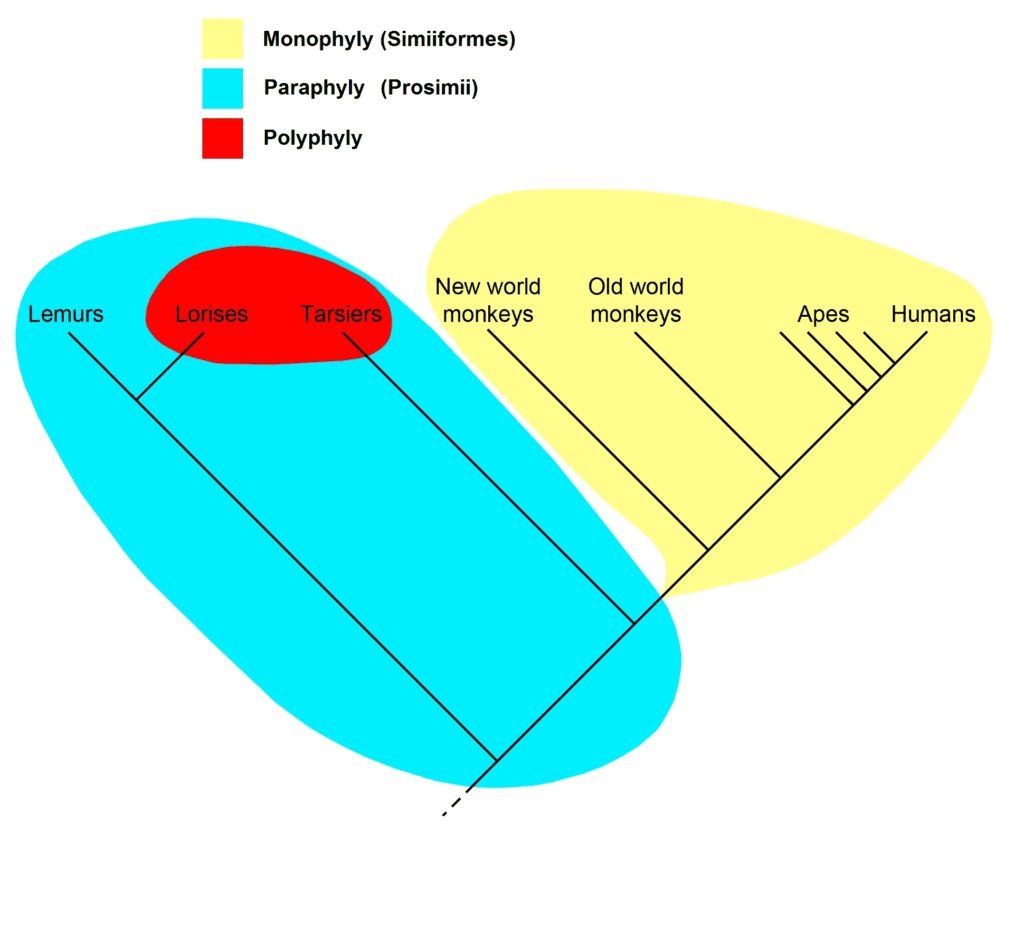Well, I’ll be a monkey’s uncle! Although it was shocking at first, we now accept that other apes share 99% of our genes. However, what even makes an ape, and are humans apes too? To tell the story of whether or not humans are apes, we need to venture on a linguistic journey.
The meaning of the word “ape” has changed over time and has been used to describe different things. The reason for this change over time is the amount of knowledge that we have of other primates. Additionally, scientists use the word differently than you or I would in everyday use.
Historically, the word “ape” has been used to differentiate between humans and, well, other primates. After the word “monkey” was introduced into the English language, it was either used as a synonym for “ape” (according to a 1910 Encyclopaedia Britannica entry) or to specifically name primates without tails.
Some monkeys even have the word “ape” in their name, such as the Barbary ape. In everyday usage, the terms ‘monkey’ and ‘ape’ are often used interchangeably. However, in modern biology and primatology, most scientists refer to apes that are not human as “non-human” apes.

The Science of Taxonomy
Before delving into the specifics of human and ape biology, it’s important to understand how scientists classify living things. The science of taxonomy involves grouping organisms based on shared physical and genetic characteristics. At the most basic level, all living things can be grouped into one of three domains: Archaea, Bacteria, and Eukarya. The latter domain includes all plants, animals, fungi, and other organisms with a nucleus in their cells.
Within the Eukarya domain, organisms are further classified into kingdoms, phyla, classes, orders, families, genera, and species. Humans, for example, belong to the animal kingdom, the chordate phylum, the mammal class, the primate order, the hominid family, and the Homo genus. Our species’ name is Homo sapiens.
The Ape Family
So where do apes fit into this classification system? Like humans, apes are members of the primate order. Within the primate order, there are two major groups: the Strepsirrhines and the Haplorhines. Strepsirrhines include lemurs and lorises, while haplorhines include tarsiers, monkeys, apes, and humans.
Apes themselves are divided into two families: Hylobatidae and Hominidae. Hylobatidae, also known as the lesser apes, includes gibbons and siamangs. Hominidae, or the great apes, include orangutans, gorillas, chimpanzees, bonobos, and humans.
A designation that has remained fluid throughout history
In the first half of the 20th century and before, primates were arranged in grade from least advanced to humans. Monkeys were considered less advanced than apes and were distinguished this way. In the 1940s, some scientists, such as Frederic Wood Jones, challenged this idea that complexity simply increased from lemurs to monkeys to apes to humans. He believed that primate relationships are complex and marked by parallel evolution. He, along with other researchers, started establishing the relationships between the different primates.

Apes and the tree of life
When scientists started putting together the tree of life, humans and “apes” were completely separate groups. Chimpanzees, gorillas, orangutans, and gibbons were considered to be in one group, and humans in a separate group.

In the past 50 years, scientists learned more about the relationships between the species with molecular studies. They found that gibbons form a separate group, but that humans are very closely related to chimpanzees and gorillas. When humans were considered very different, the term “ape” was used to describe this group of other primates that we were different from. But now that we know that we’re very similar and actually part of the same grouping, this old definition doesn’t work so well. If you say “Oh, just chimps, gorillas, gibbons, and orangutans are apes” then you are creating an artificial group, because humans should be part of this group by their relatedness.

Biologists don’t like groups that only include a few of their members because they aren’t very informative or representative. They instead use monophyletic groups that include all of the descendants of a common ancestor. “Ape” now becomes another word for Hominoid, the all-encompassing group that includes humans, gorillas, chimps, orangutans, and gibbons. Within this group, humans are included with the rest of the great apes. The term “great apes” specifically includes humans too. Scientists distinguish between humans by calling them Hominin and others as “non-human apes”.

Physical Similarities
So what physical traits do humans share with other apes that make us part of the same family? Perhaps the most obvious is our lack of a tail. Unlike many other mammals, including monkeys, apes and humans do not have a tail extending from the end of their spine.
Another shared characteristic is our opposable thumbs. Humans, along with other apes, have thumbs that can move independently of the other fingers, allowing us to grasp and manipulate objects with great precision.
A third shared trait is our large brains. While humans have the largest brains relative to body size, other apes also have relatively large brains compared to other mammals. In fact, chimpanzees have been shown to have cognitive abilities that are similar to those of young human children.
Genetic Similarities
But it’s not just physical characteristics that link humans to other apes. Our genetic makeup also provides evidence of our shared ancestry. Humans share around 98.8% of our DNA with chimpanzees and 96% with gorillas. Even our more distant relatives, such as orangutans, share around 97% of our DNA.
While these similarities may seem small, they represent a significant link between humans and other apes. The genetic similarities between humans and other primates are overwhelming.
Many opinions
However, there is still a great deal of disagreement, even in the scientific community, about whether humans are considered apes. Many, as previously mentioned, consider this whole Hominoid group as apes. Other scientists still use the historical definition, to describe non-human primates.
Indeed, this is the most common in everyday usage for laypeople too. The Merriam-Webster dictionary defines an ape as “any of various large tailless semi-erect primates of Africa and southeastern Asia (such as the chimpanzee, gorilla, orangutan, or gibbon)”.
Some researchers argue that we are not apes but ex-apes because we are fundamentally different from other apes. These differences are due to the way we communicate and other things that are not visible just by looking at DNA. In this case, the word “ape” should mean something different than Hominoid.

Unfortunately, there isn’t a straightforward answer to the question of whether humans are apes or not. The most common consensus is that non-human primates are considered apes, but many biologists are increasingly designating humans as part of this simian clade.






